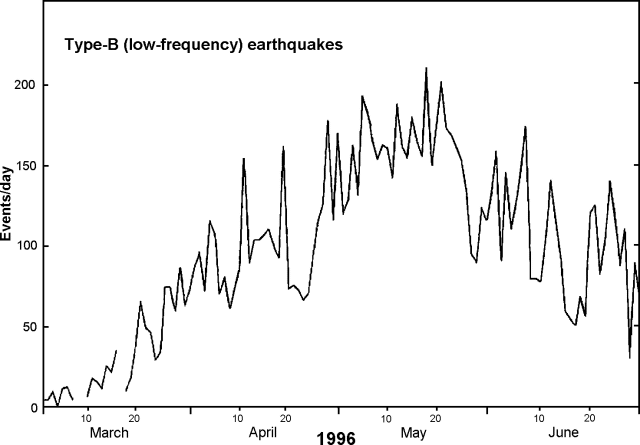Report on Popocatepetl (Mexico) — August 1996
Bulletin of the Global Volcanism Network, vol. 21, no. 8 (August 1996)
Managing Editor: Richard Wunderman.
Popocatepetl (Mexico) New dome exceeds 107 m3; B-type seismicity peaked in May
Please cite this report as:
Global Volcanism Program, 1996. Report on Popocatepetl (Mexico) (Wunderman, R., ed.). Bulletin of the Global Volcanism Network, 21:8. Smithsonian Institution. https://doi.org/10.5479/si.GVP.BGVN199608-341090
Popocatepetl
Mexico
19.023°N, 98.622°W; summit elev. 5393 m
All times are local (unless otherwise noted)
Seismicity was monitored using the N-flank PPM seismic station at 3,900 m elevation. Seismic events were classified into three types (A, B, and AB) according to the definitions given in BGVN 19:01. Type-B (low-frequency) events dominated; between March and June a total of 11,678 type-B events was recorded, but only 17 type-A and seven type-AB events were registered. Numbers of daily type-B events varied greatly during March-June (figure 15). The highest and lowest values occurred on 18 May (209 events) and on 2 June (31 events), respectively.
 |
Figure 15. Type-B (low-frequency) earthquakes at Popocatépetl during March-June, 1996. Courtesy of Carlos Valdés-González, Guillermo González-Pomposo, and Alejandra Arciniega Ceballos, UNAM. |
A new eruption began on 5 March and an explosion on 30 April killed five climbers (BGVN 21:03 and 21:04). A new lava dome was first seen on 29 March and was estimated to occupy ~1.1 x 107 m3 on 26 May.
Geological Summary. Volcán Popocatépetl, whose name is the Aztec word for smoking mountain, rises 70 km SE of Mexico City to form North America's 2nd-highest volcano. The glacier-clad stratovolcano contains a steep-walled, 400 x 600 m wide crater. The generally symmetrical volcano is modified by the sharp-peaked Ventorrillo on the NW, a remnant of an earlier volcano. At least three previous major cones were destroyed by gravitational failure during the Pleistocene, producing massive debris-avalanche deposits covering broad areas to the south. The modern volcano was constructed south of the late-Pleistocene to Holocene El Fraile cone. Three major Plinian eruptions, the most recent of which took place about 800 CE, have occurred since the mid-Holocene, accompanied by pyroclastic flows and voluminous lahars that swept basins below the volcano. Frequent historical eruptions, first recorded in Aztec codices, have occurred since Pre-Columbian time.
Information Contacts: Carlos Valdés-González, Guillermo González-Pomposo1, and Alejandra Arciniega Ceballos, Departamento de Sismología y Volcanología, Instituto de Geofísica, UNAM, Cd. Universitaría, 04510, D.F., México. 1Also at Benemérita Universidad Autónoma de Puebla, México.

